| Publications | Presentations | IDIO | Blogs | Videos | Modules |
|---|
Reports and briefs developed by the Center for IDEA Early Childhood Data Systems (DaSy Center) in response to state-identified needs.
2024
- Using Data Frameworks to Improve Services and Address Inequities for Young Children with DisabilitiesThis presentation highlighted two data frameworks that can support states in addressing equity: DaSy’s Data Systems Framework and Child Trends’ System Transformation for Equitable Preschools (STEP Forward with Data) Framework.Read more
- Clear, Complete, and Confident: Submitting a Quality APRThis presentation at the 2024 IDIO conference provided information and resources to help states to build a solid understanding of the SPP/APR indicators and the nuances of each calculation. Resources ...Read more
 Automated Sharing of Transition Data: Next Steps for StatesThis IDIO Workshop on Data Linking and Integration highlighted tools and strategies to improve DLI for Part C to B transition. Participants collaborated to identify challenges and solutions with their ...Read more
Automated Sharing of Transition Data: Next Steps for StatesThis IDIO Workshop on Data Linking and Integration highlighted tools and strategies to improve DLI for Part C to B transition. Participants collaborated to identify challenges and solutions with their ...Read more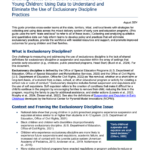 Ensuring Access and Positive Outcomes for All Young Children: Using Data to Understand and Eliminate the Use of Exclusionary Discipline PracticesThis guide provides cross-sector teams at the state, territory, tribal, and local levels with strategies for collecting and using data across the mixed delivery system of early care and education ...Read more
Ensuring Access and Positive Outcomes for All Young Children: Using Data to Understand and Eliminate the Use of Exclusionary Discipline PracticesThis guide provides cross-sector teams at the state, territory, tribal, and local levels with strategies for collecting and using data across the mixed delivery system of early care and education ...Read more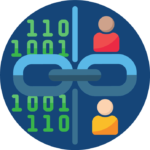 The DaSy Center Supports North Carolina’s Journey to Link IDEA Part C and Part B 619 DataDaSy and one state’s journey to link IDEA Part C and Part B 619 datasets to enable analyses and provide a deeper understanding of how children transition from one program ...Read more
The DaSy Center Supports North Carolina’s Journey to Link IDEA Part C and Part B 619 DataDaSy and one state’s journey to link IDEA Part C and Part B 619 datasets to enable analyses and provide a deeper understanding of how children transition from one program ...Read more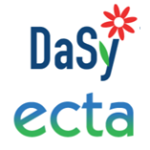 Elevating Family Voices: How ECTA and DaSy Technical Assistance Supports State Innovations for Equitable Family InputStories from two states highlight the support that DaSy and/or ECTA can provide to Part C and Part B 619 programs seeking to improve their system, service implementation, and child ...Read more
Elevating Family Voices: How ECTA and DaSy Technical Assistance Supports State Innovations for Equitable Family InputStories from two states highlight the support that DaSy and/or ECTA can provide to Part C and Part B 619 programs seeking to improve their system, service implementation, and child ...Read more Automated Data Sharing or Linking Use Case: IDEA Part C to Part B 619 Transition NotificationThis is a resource for Part C and Part B 619 program staff looking to share or link their IDEA Part C to Part B 619 transition notification data. This ...Read more
Automated Data Sharing or Linking Use Case: IDEA Part C to Part B 619 Transition NotificationThis is a resource for Part C and Part B 619 program staff looking to share or link their IDEA Part C to Part B 619 transition notification data. This ...Read more
2023
 IDEA Child Outcomes Highlights for FFY 2021The Individuals with Disabilities Education Act (IDEA) funds programs providing services designed to assist children with a range of delays and disabilities in achieving individualized developmental and functional goals. There ...Read more
IDEA Child Outcomes Highlights for FFY 2021The Individuals with Disabilities Education Act (IDEA) funds programs providing services designed to assist children with a range of delays and disabilities in achieving individualized developmental and functional goals. There ...Read more Quick Reference Guide on the Timely Expenditure of IDEA FundsThis new guide helps state staff and others understand obligation and liquidation requirements and timelines, the grant funding cycle, and oversight responsibilities,Read more
Quick Reference Guide on the Timely Expenditure of IDEA FundsThis new guide helps state staff and others understand obligation and liquidation requirements and timelines, the grant funding cycle, and oversight responsibilities,Read more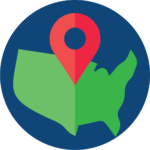 2021 State of the States Brief: The COVID-19 Pandemic as Captured by Part C and Part B 619 Data SystemsThe COVID-19 pandemic presented unique challenges for states’ Part C and Part B 619 data collection and reporting. The spring 2021 State of the States survey provides a snapshot of ...Read more
2021 State of the States Brief: The COVID-19 Pandemic as Captured by Part C and Part B 619 Data SystemsThe COVID-19 pandemic presented unique challenges for states’ Part C and Part B 619 data collection and reporting. The spring 2021 State of the States survey provides a snapshot of ...Read more 2023 State Learning OpportunitiesThe OSEP-funded Early Childhood Technical Assistance (TA) Centers are pleased to announce a variety of new and ongoing opportunities to build individual and state capacity around implementation of IDEA 0-5 ...Read more
2023 State Learning OpportunitiesThe OSEP-funded Early Childhood Technical Assistance (TA) Centers are pleased to announce a variety of new and ongoing opportunities to build individual and state capacity around implementation of IDEA 0-5 ...Read more Fiscal Data Trend Profile Template (2023)For a Part C system, the fiscal data profile depicts demographic, service delivery, infrastructure, and administrative data in a variety of ways to make the fiscal data more comprehensible to ...Read more
Fiscal Data Trend Profile Template (2023)For a Part C system, the fiscal data profile depicts demographic, service delivery, infrastructure, and administrative data in a variety of ways to make the fiscal data more comprehensible to ...Read more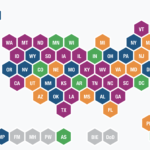 Map of Approaches to Family Outcomes Measurement: Part C APR Indicator 4 FFY 2020 (2020–2021)Some states used additional tools/approaches to measure other family variables. States use survey methods to collect family outcomes data, but the questions and processes vary.Read more
Map of Approaches to Family Outcomes Measurement: Part C APR Indicator 4 FFY 2020 (2020–2021)Some states used additional tools/approaches to measure other family variables. States use survey methods to collect family outcomes data, but the questions and processes vary.Read more COS-KC Data Key for All Data ReportA document that includes information about each of the fields included in the COS-KC All Data report. If you need more information, contact your DaSy TA liaison. COS-KC Data Key for ...Read more
COS-KC Data Key for All Data ReportA document that includes information about each of the fields included in the COS-KC All Data report. If you need more information, contact your DaSy TA liaison. COS-KC Data Key for ...Read more OSEP Early Childhood TA Centers FlyerThe OSEP Early Childhood TA Centers flyer is designed to help states better understand the content focus of the OSEP TA centers and the network of parent centers that respond ...Read more
OSEP Early Childhood TA Centers FlyerThe OSEP Early Childhood TA Centers flyer is designed to help states better understand the content focus of the OSEP TA centers and the network of parent centers that respond ...Read more
2022
 2021 DaSy Data Systems (State of the States) Survey FindingsDaSy collects comprehensive information on the status of Part C and Part B 619 data systems through the State of the States survey, which comprises a survey of Part C ...Read more
2021 DaSy Data Systems (State of the States) Survey FindingsDaSy collects comprehensive information on the status of Part C and Part B 619 data systems through the State of the States survey, which comprises a survey of Part C ...Read more Data Leadership Competencies for Part C and Part B 619Data can help Part C and Part B 619 program coordinators, data managers and staff improve outcomes for children and families by strengthening their understanding of the needs of the ...Read more
Data Leadership Competencies for Part C and Part B 619Data can help Part C and Part B 619 program coordinators, data managers and staff improve outcomes for children and families by strengthening their understanding of the needs of the ...Read more IDEA Child Outcomes Highlights for FFY 2020For Part C Early Intervention, a comparison of national averages from FFY 2019 to FFY 2020 showed increases in some outcomes and decreases in others. There was an increase in ...Read more
IDEA Child Outcomes Highlights for FFY 2020For Part C Early Intervention, a comparison of national averages from FFY 2019 to FFY 2020 showed increases in some outcomes and decreases in others. There was an increase in ...Read more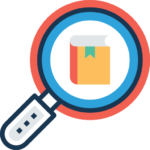 Analysis Steps Used to Generate National Estimates for Progress Categories, Summary Statements, and Results FFY 2020National estimates were computed using three methods: (1) Computing weighted national estimates for all states, (2) Computing the unweighted national estimates for all states, and (3) Computing the weighted national ...Read more
Analysis Steps Used to Generate National Estimates for Progress Categories, Summary Statements, and Results FFY 2020National estimates were computed using three methods: (1) Computing weighted national estimates for all states, (2) Computing the unweighted national estimates for all states, and (3) Computing the weighted national ...Read more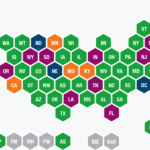 State Approaches to Child Outcomes Measurement: Part C APR Indicator 3 FFY 2020 (2020–2021)States use several different approaches to measure child outcomes, as illustrated in these maps compiled by DaSy & ECTA. Most states use the Child Outcomes Summary Process, a team process ...Read more
State Approaches to Child Outcomes Measurement: Part C APR Indicator 3 FFY 2020 (2020–2021)States use several different approaches to measure child outcomes, as illustrated in these maps compiled by DaSy & ECTA. Most states use the Child Outcomes Summary Process, a team process ...Read more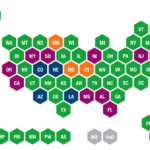 State Approaches to Child Outcomes Measurement: Part B APR Indicator 7 (Section 619/Preschool) FFY 2020 (2020–2021)States use several different approaches to measure child outcomes, as illustrated in these maps compiled by DaSy & ECTA. Most states use the Child Outcomes Summary Process, a team process ...Read more
State Approaches to Child Outcomes Measurement: Part B APR Indicator 7 (Section 619/Preschool) FFY 2020 (2020–2021)States use several different approaches to measure child outcomes, as illustrated in these maps compiled by DaSy & ECTA. Most states use the Child Outcomes Summary Process, a team process ...Read more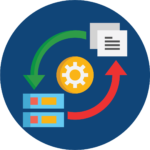 DaSy Data System FrameworkSupporting Part C and Part B 619 programs developing state data systems.Read more
DaSy Data System FrameworkSupporting Part C and Part B 619 programs developing state data systems.Read more Understanding Functional Skills: Background for the COS ProcessThis resource helps teams think about measuring a child’s use and integration of functional skills to participate in their everyday routines. This resource will help teams further their understanding of ...Read more
Understanding Functional Skills: Background for the COS ProcessThis resource helps teams think about measuring a child’s use and integration of functional skills to participate in their everyday routines. This resource will help teams further their understanding of ...Read more Aligning a Child’s Functional Skills with the Breadth of the Three Child OutcomesThis resource supports high-quality Child Outcomes Summary (COS) ratings by helping teams connect their observations of children’s functional skills and behaviors with the three child outcomes. Effectively aligning functional skills ...Read more
Aligning a Child’s Functional Skills with the Breadth of the Three Child OutcomesThis resource supports high-quality Child Outcomes Summary (COS) ratings by helping teams connect their observations of children’s functional skills and behaviors with the three child outcomes. Effectively aligning functional skills ...Read more Data Linking ToolkitThis DaSy toolkit provides an overview of data linking and tools to support Part C and Part B 619 program staff as they consider, prepare, and successfully link their data. ...Read more
Data Linking ToolkitThis DaSy toolkit provides an overview of data linking and tools to support Part C and Part B 619 program staff as they consider, prepare, and successfully link their data. ...Read more Part C General Supervision Monitoring Procedures ChecklistA lead agency’s general supervision system is the mechanism for enforcing federal requirements and for ensuring continuous improvement. This information might be described in one or more state manuals, documents ...Read more
Part C General Supervision Monitoring Procedures ChecklistA lead agency’s general supervision system is the mechanism for enforcing federal requirements and for ensuring continuous improvement. This information might be described in one or more state manuals, documents ...Read more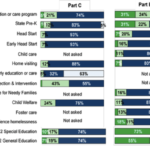 Early Intervention and Early Childhood Special Education State Data Systems: Current Status and Changes between 2013 and 2021Conference: National Research Conference on Early Childhood (NRCEC) Date: June 2022 Presenters: Nancy Perez, Kathleen Hebbeler, Grace Kelley, Cornelia Taylor This poster reports responses for 50 states, DC, and Puerto Rico on changes ...Read more
Early Intervention and Early Childhood Special Education State Data Systems: Current Status and Changes between 2013 and 2021Conference: National Research Conference on Early Childhood (NRCEC) Date: June 2022 Presenters: Nancy Perez, Kathleen Hebbeler, Grace Kelley, Cornelia Taylor This poster reports responses for 50 states, DC, and Puerto Rico on changes ...Read more Tools for Improving Child FindTools designed by DaSy and ECTA to support the collection, review, and improvement of child find systems including 618 data, including the OSEP Part B 619 Child Find Self-Assessment ...Read more
Tools for Improving Child FindTools designed by DaSy and ECTA to support the collection, review, and improvement of child find systems including 618 data, including the OSEP Part B 619 Child Find Self-Assessment ...Read more Data Sharing Partnerships Improve SystemsPartnerships between the Early Hearing Detection and Intervention (EHDI) program and Part C of the Individuals with Disabilities Education Act (IDEA) program can support and improve outcomes for children who ...Read more
Data Sharing Partnerships Improve SystemsPartnerships between the Early Hearing Detection and Intervention (EHDI) program and Part C of the Individuals with Disabilities Education Act (IDEA) program can support and improve outcomes for children who ...Read more IDEA Part C and Part B 619 State Data Systems: Current Status and Changes from 2013 to 2019This DaSy report presents a comprehensive look at the status of Part C and Part B 619 state data systems in 2019. It includes what data states are collecting, what ...Read more
IDEA Part C and Part B 619 State Data Systems: Current Status and Changes from 2013 to 2019This DaSy report presents a comprehensive look at the status of Part C and Part B 619 state data systems in 2019. It includes what data states are collecting, what ...Read more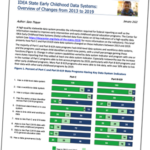 IDEA State Early Childhood Data Systems: Overview of Changes from 2013 to 2019This DaSy brief presents how Part C and Part B 619 state data systems changed on 10 key indicators of a high-quality data system (see more information on the indicators) ...Read more
IDEA State Early Childhood Data Systems: Overview of Changes from 2013 to 2019This DaSy brief presents how Part C and Part B 619 state data systems changed on 10 key indicators of a high-quality data system (see more information on the indicators) ...Read more 2022 State Learning OpportunitiesThe OSEP-funded Early Childhood Technical Assistance (TA) Centers are pleased to announce a variety of new and ongoing opportunities to build individual and state capacity around implementation of IDEA 0-5. ...Read more
2022 State Learning OpportunitiesThe OSEP-funded Early Childhood Technical Assistance (TA) Centers are pleased to announce a variety of new and ongoing opportunities to build individual and state capacity around implementation of IDEA 0-5. ...Read more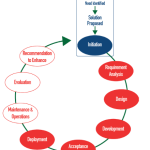 Key Considerations for Initiating and Planning a New Data System or Data System EnhancementThis 2021 DaSy brief is an updated version of the 2015 document and presents key considerations in the form of questions that can be used to help clarify program needs ...Read more
Key Considerations for Initiating and Planning a New Data System or Data System EnhancementThis 2021 DaSy brief is an updated version of the 2015 document and presents key considerations in the form of questions that can be used to help clarify program needs ...Read more
2021
 Telepractice for Part C Early Intervention Services: Considerations for Effective Implementation and Medicaid ReimbursementSupport states in securing Medicaid coverage for telepractice as a method of service delivery beyond the public health emergency of the COVID-19 pandemic…Read more
Telepractice for Part C Early Intervention Services: Considerations for Effective Implementation and Medicaid ReimbursementSupport states in securing Medicaid coverage for telepractice as a method of service delivery beyond the public health emergency of the COVID-19 pandemic…Read more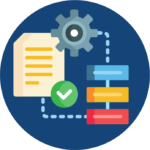 Tip Sheet Series: Evaluating the Implementation of Evidence-based PracticesThis DaSy tip sheet series provides concise guidance for collecting and analyzing high-quality data on the implementation of evidence-based practices.Read more
Tip Sheet Series: Evaluating the Implementation of Evidence-based PracticesThis DaSy tip sheet series provides concise guidance for collecting and analyzing high-quality data on the implementation of evidence-based practices.Read more Considerations of the Impact of COVID-19 on APR Indicator DataThe COVID-19 pandemic caused unintended changes to state Part C program policies, procedures, and practices that may have impacted program performance. State data collection and reporting activities were also disrupted, ...Read more
Considerations of the Impact of COVID-19 on APR Indicator DataThe COVID-19 pandemic caused unintended changes to state Part C program policies, procedures, and practices that may have impacted program performance. State data collection and reporting activities were also disrupted, ...Read more Analysis Steps Used to Generate National Estimates for Progress Categories, Summary Statements, and Results FFY2019Learn about the three methods used to compute national estimates for progress categories, summary statements, and results FFY2019.Read more
Analysis Steps Used to Generate National Estimates for Progress Categories, Summary Statements, and Results FFY2019Learn about the three methods used to compute national estimates for progress categories, summary statements, and results FFY2019.Read more Finance GlossaryThis glossary contains terms relevant to finance for IDEA Part C and Part B, Section 619 programs. The terms include reference to IDEA and other related federal fiscal requirements as ...Read more
Finance GlossaryThis glossary contains terms relevant to finance for IDEA Part C and Part B, Section 619 programs. The terms include reference to IDEA and other related federal fiscal requirements as ...Read more Part C Data System FunctionsThis DaSy Part C Data System Functions resource contains a list of Part C data system functions designed to assist in developing and enhancing high-quality state data systems. The ...Read more
Part C Data System FunctionsThis DaSy Part C Data System Functions resource contains a list of Part C data system functions designed to assist in developing and enhancing high-quality state data systems. The ...Read more IDEA Child Outcomes Highlights for FFY2019Between FFY2018 and 2019 there were declines in the percentage of children making gains (Summary Statement 1) and those reaching age expectations (Summary statement 2) in Part C and the ...Read more
IDEA Child Outcomes Highlights for FFY2019Between FFY2018 and 2019 there were declines in the percentage of children making gains (Summary Statement 1) and those reaching age expectations (Summary statement 2) in Part C and the ...Read more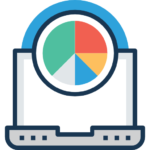 Summary of State and Jurisdictional Eligibility Definitions for Infants and Toddlers with Disabilities Under IDEA Part CThis infographic summarizes national variations in eligibility policies for infants and toddlers from birth to age 3 enrolling in early intervention programs under Part C of IDEA.Read more
Summary of State and Jurisdictional Eligibility Definitions for Infants and Toddlers with Disabilities Under IDEA Part CThis infographic summarizes national variations in eligibility policies for infants and toddlers from birth to age 3 enrolling in early intervention programs under Part C of IDEA.Read more Improving Part C Results and Compliance: A Six-Step Inquiry CycleThis six-step inquiry process helps states improve educational results and functional outcomes for children with disabilities while ensuring compliance with Individuals with Disabilities Education Act (IDEA) through state monitoring activities. ...Read more
Improving Part C Results and Compliance: A Six-Step Inquiry CycleThis six-step inquiry process helps states improve educational results and functional outcomes for children with disabilities while ensuring compliance with Individuals with Disabilities Education Act (IDEA) through state monitoring activities. ...Read more Breadth of the Three Child OutcomesThe three child outcomes, measured by early intervention and early childhood special education systems, encompass functional skills and behaviors that are meaningful for a child’s participation in everyday routines. They ...Read more
Breadth of the Three Child OutcomesThe three child outcomes, measured by early intervention and early childhood special education systems, encompass functional skills and behaviors that are meaningful for a child’s participation in everyday routines. They ...Read more COVID-19 Guidance for IDEA Programs: Policy and TA Checklist for Part C LeadersThis DaSy and ECTA checklist provides guidance to Part C leaders to use during the COVID-19 pandemic.Read more
COVID-19 Guidance for IDEA Programs: Policy and TA Checklist for Part C LeadersThis DaSy and ECTA checklist provides guidance to Part C leaders to use during the COVID-19 pandemic.Read more Resources to Increase Virtual EngagementThis handout highlights 5 tools to help you increase virtual engagement.Read more
Resources to Increase Virtual EngagementThis handout highlights 5 tools to help you increase virtual engagement.Read more A State Guide on Identifying, Correcting, and Reporting Noncompliance with IDEA RequirementsThe Individuals with Disabilities Education Act (IDEA) requires states to monitor and enforce IDEA Part C and Part B requirements, with a primary focus on those requirements that are most ...Read more
A State Guide on Identifying, Correcting, and Reporting Noncompliance with IDEA RequirementsThe Individuals with Disabilities Education Act (IDEA) requires states to monitor and enforce IDEA Part C and Part B requirements, with a primary focus on those requirements that are most ...Read more 2021 State Learning OpportunitiesThe OSEP-funded Early Childhood Technical Assistance (TA) Centers are pleased to announce a variety of new and ongoing opportunities to build individual and state capacity around implementation of IDEA 0-5. ...Read more
2021 State Learning OpportunitiesThe OSEP-funded Early Childhood Technical Assistance (TA) Centers are pleased to announce a variety of new and ongoing opportunities to build individual and state capacity around implementation of IDEA 0-5. ...Read more Building the Case to Expand Medicaid and Private Insurance for Early InterventionThese video interviews recounting state stories, a planning tool, and related presentations are integrated components to maximize your learning and provide the information you need to be successful expanding coverage ...Read more
Building the Case to Expand Medicaid and Private Insurance for Early InterventionThese video interviews recounting state stories, a planning tool, and related presentations are integrated components to maximize your learning and provide the information you need to be successful expanding coverage ...Read more Part C Child Find Self-Assessment: Quick Start GuideThe Part C Child Find Self-Assessment: Quick Start Guide, developed by DaSy and ECTA, is designed to help state leaders consider common areas of need and challenges related to Child ...Read more
Part C Child Find Self-Assessment: Quick Start GuideThe Part C Child Find Self-Assessment: Quick Start Guide, developed by DaSy and ECTA, is designed to help state leaders consider common areas of need and challenges related to Child ...Read more Remote Screening, Evaluation, and Assessment ResourcesMany assessment practices can be successfully implemented even when the practitioner cannot be in the same room with the child and family such as during the COVID-19 pandemic. The resources ...Read more
Remote Screening, Evaluation, and Assessment ResourcesMany assessment practices can be successfully implemented even when the practitioner cannot be in the same room with the child and family such as during the COVID-19 pandemic. The resources ...Read more IDEA Part C Data NotesThe IDEA Part C Data Notes brief describes the purpose of data notes for Part C 618 data collections and how they are used in OSEP’s data quality review process. ...Read more
IDEA Part C Data NotesThe IDEA Part C Data Notes brief describes the purpose of data notes for Part C 618 data collections and how they are used in OSEP’s data quality review process. ...Read more
2020
 DaSy IDEA Part C Data Reporting Reference GuideThis quick reference guide has important dates, links, and resources in one place to help with IDEA Part C data requirements.Read more
DaSy IDEA Part C Data Reporting Reference GuideThis quick reference guide has important dates, links, and resources in one place to help with IDEA Part C data requirements.Read more Assessment Tools for Planning Instruction and Monitoring Young Children’s Progress RemotelyThis table includes instruments that compare a child’s performance against a set of standards or criteria that often reflect developmental sequences. Assessment Tools for Planning Instruction and Monitoring Young Children’s Progress ...Read more
Assessment Tools for Planning Instruction and Monitoring Young Children’s Progress RemotelyThis table includes instruments that compare a child’s performance against a set of standards or criteria that often reflect developmental sequences. Assessment Tools for Planning Instruction and Monitoring Young Children’s Progress ...Read more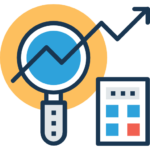 Norm-Referenced Assessment Tools for Children Birth to Age Five Years with Potential for Remote Administration for Eligibility DeterminationThis table includes standardized instruments which provide information on a child’s performance relative to a norming group. Norm-Referenced Assessment Tools for Children Birth to Age Five Years with Potential for Remote ...Read more
Norm-Referenced Assessment Tools for Children Birth to Age Five Years with Potential for Remote Administration for Eligibility DeterminationThis table includes standardized instruments which provide information on a child’s performance relative to a norming group. Norm-Referenced Assessment Tools for Children Birth to Age Five Years with Potential for Remote ...Read more Screening Tools for Children Birth to Age Five Years with Potential for Remote AdministrationThis table includes tools which provide information about whether a child’s performance is consistent with age-expected functioning or needs further evaluation. Screening Tools for Children Birth to Age Five Years with ...Read more
Screening Tools for Children Birth to Age Five Years with Potential for Remote AdministrationThis table includes tools which provide information about whether a child’s performance is consistent with age-expected functioning or needs further evaluation. Screening Tools for Children Birth to Age Five Years with ...Read more Determining A Child’s Eligibility for Early Intervention Services RemotelyIncluded here are guidance, considerations, and resources for state staff and local practitioners who are determining Part C eligibility remotely. As a result of COVID-19, many states are having to ...Read more
Determining A Child’s Eligibility for Early Intervention Services RemotelyIncluded here are guidance, considerations, and resources for state staff and local practitioners who are determining Part C eligibility remotely. As a result of COVID-19, many states are having to ...Read more COS Completion When Teams Can’t Meet In PersonThis document is intended to assist teams conducting COS rating determination meetings using telecommunication devices such as phones and/or computers with or without video to have discussions with team members ...Read more
COS Completion When Teams Can’t Meet In PersonThis document is intended to assist teams conducting COS rating determination meetings using telecommunication devices such as phones and/or computers with or without video to have discussions with team members ...Read more IDEA Child Outcomes Highlights for FFY2018The Individuals with Disabilities Education Act (IDEA) funds programs providing services designed to assist children with a range of delays and disabilities in achieving individualized developmental and functional goals. The ...Read more
IDEA Child Outcomes Highlights for FFY2018The Individuals with Disabilities Education Act (IDEA) funds programs providing services designed to assist children with a range of delays and disabilities in achieving individualized developmental and functional goals. The ...Read more The Early Childhood TA Response During the COVID-19 CrisisWe are all working to address the best way to proceed with our work and our personal lives. We have adopted the following principles as we continue to focus on ...Read more
The Early Childhood TA Response During the COVID-19 CrisisWe are all working to address the best way to proceed with our work and our personal lives. We have adopted the following principles as we continue to focus on ...Read more Key Part C Data Considerations during COVID-19The purpose of this document is to provide a preliminary set of data considerations for Part C systems to understand the evolving impact of COVID-19 on services, programs and administrative ...Read more
Key Part C Data Considerations during COVID-19The purpose of this document is to provide a preliminary set of data considerations for Part C systems to understand the evolving impact of COVID-19 on services, programs and administrative ...Read more Child Find Self-AssessmentThe Child Find Self-Assessment (CFSA) is a valuable tool for State IDEA Part C programs seeking to improve their child find efforts. Developed by the Office of Special Education Programs ...Read more
Child Find Self-AssessmentThe Child Find Self-Assessment (CFSA) is a valuable tool for State IDEA Part C programs seeking to improve their child find efforts. Developed by the Office of Special Education Programs ...Read more
2019
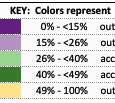 619 Child Outcomes Data Completeness CalculatorThis 619 Child Outcomes Data Completeness Calculator is an Excel-based analytic tool that can be used to determine the percent of children exiting the program with complete child outcomes data ...Read more
619 Child Outcomes Data Completeness CalculatorThis 619 Child Outcomes Data Completeness Calculator is an Excel-based analytic tool that can be used to determine the percent of children exiting the program with complete child outcomes data ...Read more Part C Child Find Funnel Chart ToolThe Child Find Funnel Chart tool is an Excel template for displaying data about infants and toddlers at each step of the Part C process, from referral through exit, for ...Read more
Part C Child Find Funnel Chart ToolThe Child Find Funnel Chart tool is an Excel template for displaying data about infants and toddlers at each step of the Part C process, from referral through exit, for ...Read more
2018
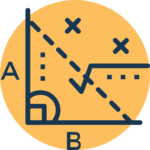 Excel calculator for computing the Number and Percentage of Infants and Toddlers who did not Receive Early Intervention Services for at Least Six MonthsThis Excel tool can be used to compute the difference between valid entry and exit dates for children receiving early intervention services and count the number of children with less ...Read more
Excel calculator for computing the Number and Percentage of Infants and Toddlers who did not Receive Early Intervention Services for at Least Six MonthsThis Excel tool can be used to compute the difference between valid entry and exit dates for children receiving early intervention services and count the number of children with less ...Read more Guidance for computing the Number and Percentage of Infants and Toddlers who did not Receive Early Intervention Services for at Least Six MonthsThis Word document provides guidance for states that can support the calculation of the Number and Percentage of Infants and Toddlers who Received Early Intervention Services for at Least Six ...Read more
Guidance for computing the Number and Percentage of Infants and Toddlers who did not Receive Early Intervention Services for at Least Six MonthsThis Word document provides guidance for states that can support the calculation of the Number and Percentage of Infants and Toddlers who Received Early Intervention Services for at Least Six ...Read more Identify Meaningful Differences in Child FindThis Excel-based calculator allows states to make several comparisons related to the percentage of infants and toddlers served: State percentage compared to state target, local program percentage compared to ...Read more
Identify Meaningful Differences in Child FindThis Excel-based calculator allows states to make several comparisons related to the percentage of infants and toddlers served: State percentage compared to state target, local program percentage compared to ...Read more Age Anchoring Guidance for Determining Child Outcomes Summary (COS) RatingsThis 2018 document provides answers to commonly asked questions about age anchoring as it applies to the COS process. It is designed as a reference for practitioners, as well as ...Read more
Age Anchoring Guidance for Determining Child Outcomes Summary (COS) RatingsThis 2018 document provides answers to commonly asked questions about age anchoring as it applies to the COS process. It is designed as a reference for practitioners, as well as ...Read more Extending the COS Process Module: Professional Development ActivitiesThese 2018 documents are intended to help states supplement and reinforce the information in the Child Outcomes Summary (COS) Process online learning module. Guidance for Preparing and Implementing Effective Training ...Read more
Extending the COS Process Module: Professional Development ActivitiesThese 2018 documents are intended to help states supplement and reinforce the information in the Child Outcomes Summary (COS) Process online learning module. Guidance for Preparing and Implementing Effective Training ...Read more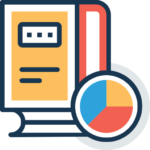 Year-to-Year Changes in State Child Outcomes Data: What Do They Mean?Interpreting year-to-year change in statewide child outcomes data requires understanding the possible reasons for fluctuations. This brief is designed to help stakeholders learn what questions to ask to understand year-to-year ...Read more
Year-to-Year Changes in State Child Outcomes Data: What Do They Mean?Interpreting year-to-year change in statewide child outcomes data requires understanding the possible reasons for fluctuations. This brief is designed to help stakeholders learn what questions to ask to understand year-to-year ...Read more Strengthening SSIP Evaluations with Qualitative MethodsThis 2018 report provides a broad overview of what qualitative research methods are, as well as examples and suggestions for collection high-quality qualitative data. Additionally, the report offers examples of ...Read more
Strengthening SSIP Evaluations with Qualitative MethodsThis 2018 report provides a broad overview of what qualitative research methods are, as well as examples and suggestions for collection high-quality qualitative data. Additionally, the report offers examples of ...Read more Fiscal Data Profile Template (2018)This Fiscal Data Profile Template (2018) displays fiscal data at a specific point in time. It can be used with the Fiscal Data Trend Profile Template (2023) to show trending ...Read more
Fiscal Data Profile Template (2018)This Fiscal Data Profile Template (2018) displays fiscal data at a specific point in time. It can be used with the Fiscal Data Trend Profile Template (2023) to show trending ...Read more Telling Your SSIP Story in an Infographic: Strategies, Tips, and ExamplesThis 2018 brief offers guidance on the varied uses/audiences for infographics, best practices for creating infographics, and examples of state SSIP infographics. It also offers an exemplar SSIP infographic and ...Read more
Telling Your SSIP Story in an Infographic: Strategies, Tips, and ExamplesThis 2018 brief offers guidance on the varied uses/audiences for infographics, best practices for creating infographics, and examples of state SSIP infographics. It also offers an exemplar SSIP infographic and ...Read more
2017
 State Family Outcomes Measurement System (S-FOMS) Framework and Self-AssessmentThis framework, originally developed by the Early Childhood Outcomes (ECO) Center, identifies 7 key components of a high-quality family outcomes measurement system at the state level. The following resources were ...Read more
State Family Outcomes Measurement System (S-FOMS) Framework and Self-AssessmentThis framework, originally developed by the Early Childhood Outcomes (ECO) Center, identifies 7 key components of a high-quality family outcomes measurement system at the state level. The following resources were ...Read more State Child Outcomes Measurement System (S-COMS) Framework and Self-AssessmentThis framework developed by ECTA and DaSy identifies 7 key components of a high-quality child outcomes measurement system at the local level. The following resources were developed for local Part ...Read more
State Child Outcomes Measurement System (S-COMS) Framework and Self-AssessmentThis framework developed by ECTA and DaSy identifies 7 key components of a high-quality child outcomes measurement system at the local level. The following resources were developed for local Part ...Read more Summarizing and Reporting ECTA System Framework Self-Assessment Data to Demonstrate Infrastructure Improvements for SSIP Phase IIIDeveloped by ECTA and DaSy, this document is designed to illustrate how a state might summarize and report data gathered through the System Framework self-assessment process to document infrastructure improvements ...Read more
Summarizing and Reporting ECTA System Framework Self-Assessment Data to Demonstrate Infrastructure Improvements for SSIP Phase IIIDeveloped by ECTA and DaSy, this document is designed to illustrate how a state might summarize and report data gathered through the System Framework self-assessment process to document infrastructure improvements ...Read more Local Child Outcomes Measurement System (L-COMS)This 2017 resource provides a framework that identifies seven key components of a high-quality child outcomes measurement system at the local level. The L-COMS and two related resources were developed ...Read more
Local Child Outcomes Measurement System (L-COMS)This 2017 resource provides a framework that identifies seven key components of a high-quality child outcomes measurement system at the local level. The L-COMS and two related resources were developed ...Read more State Early Childhood Inclusion Self-AssessmentThis 2017 self-assessment tool provides a framework for examining key aspects of a State infrastructure that are useful for promoting high quality inclusive practices, programs and policies. The sections of ...Read more
State Early Childhood Inclusion Self-AssessmentThis 2017 self-assessment tool provides a framework for examining key aspects of a State infrastructure that are useful for promoting high quality inclusive practices, programs and policies. The sections of ...Read more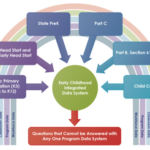 Informed & Ready: Questions Part C and Part B 619 Program Leaders Should Ask About an Early Childhood Integrated Data SystemThis 2017 brief discusses the benefits for Part C and Part B 619 program leaders of participating in an ECIDS, explores some of the questions that these leaders need to ...Read more
Informed & Ready: Questions Part C and Part B 619 Program Leaders Should Ask About an Early Childhood Integrated Data SystemThis 2017 brief discusses the benefits for Part C and Part B 619 program leaders of participating in an ECIDS, explores some of the questions that these leaders need to ...Read more Refining Your Evaluation: Refining Intended SSIP OutcomesThis 2017 document is designed for states who are currently working to refine and refocus their short and/or long term intended SSIP outcomes. It includes a worksheet to support states ...Read more
Refining Your Evaluation: Refining Intended SSIP OutcomesThis 2017 document is designed for states who are currently working to refine and refocus their short and/or long term intended SSIP outcomes. It includes a worksheet to support states ...Read more Refining Your Evaluation: Refining S.M.A.R.T. Performance IndicatorsThis 2017 document is designed to assist states develop or refine their SSIP performance indicators. It includes a worksheet with a series of questions based on S.M.A.R.T. criteria (Specific, Measurable, ...Read more
Refining Your Evaluation: Refining S.M.A.R.T. Performance IndicatorsThis 2017 document is designed to assist states develop or refine their SSIP performance indicators. It includes a worksheet with a series of questions based on S.M.A.R.T. criteria (Specific, Measurable, ...Read more Refining Your Evaluation: Data Pathway — From Source to UseThis 2017 reference tool includes a series of steps that are required to collect high quality data needed to evaluate SSIP implementation and outcomes. These steps can help states ...Read more
Refining Your Evaluation: Data Pathway — From Source to UseThis 2017 reference tool includes a series of steps that are required to collect high quality data needed to evaluate SSIP implementation and outcomes. These steps can help states ...Read more Recommended Resources for Planning to Evaluate Program Improvement Efforts (including the SSIP)This collection provides a list of recommended existing resources for state Part C and Part B 619 staff and technical assistance (TA) providers to utilize to support evaluation planning for ...Read more
Recommended Resources for Planning to Evaluate Program Improvement Efforts (including the SSIP)This collection provides a list of recommended existing resources for state Part C and Part B 619 staff and technical assistance (TA) providers to utilize to support evaluation planning for ...Read more
2016
 Building a Better Data System: What Are Process and Data Models?This DaSy report provides an overview of process modeling and data modeling and explains the value of each in the development or major enhancement of data systems. Process modeling and ...Read more
Building a Better Data System: What Are Process and Data Models?This DaSy report provides an overview of process modeling and data modeling and explains the value of each in the development or major enhancement of data systems. Process modeling and ...Read more SSIP Phase III Process GuideThis 2016 guide includes key considerations and resources to support states in implementing the SSIP and evaluating implementation progress and outcomes. Particularly useful are the Key Terms section, the lists ...Read more
SSIP Phase III Process GuideThis 2016 guide includes key considerations and resources to support states in implementing the SSIP and evaluating implementation progress and outcomes. Particularly useful are the Key Terms section, the lists ...Read more Framework Self-Assessment Comparison ToolThe Excel-based Self-Assessment Comparison Tool is intended to provide states with a mechanism to examine changes over time in the implementation of one or more components/subcomponents of the ECTA and ...Read more
Framework Self-Assessment Comparison ToolThe Excel-based Self-Assessment Comparison Tool is intended to provide states with a mechanism to examine changes over time in the implementation of one or more components/subcomponents of the ECTA and ...Read more Maryland: Establishing Partnerships to Build Data Use CapacityThis 2016 State Spotlight describes the partnership between the Maryland State Department of Education (MSDE) and the Johns Hopkins University Center for Technology in Education to build a statewide longitudinal ...Read more
Maryland: Establishing Partnerships to Build Data Use CapacityThis 2016 State Spotlight describes the partnership between the Maryland State Department of Education (MSDE) and the Johns Hopkins University Center for Technology in Education to build a statewide longitudinal ...Read more Avoid the Pitfalls: Benefits of Formal Part C Data System GovernanceThis 2016 brief promotes formal data governance for Part C data by describing lessons learned from other industries; outlining the risks of informal data governance and benefits of formal data ...Read more
Avoid the Pitfalls: Benefits of Formal Part C Data System GovernanceThis 2016 brief promotes formal data governance for Part C data by describing lessons learned from other industries; outlining the risks of informal data governance and benefits of formal data ...Read more Health Insurance Portability and Accountability Act (HIPAA) Frequently Asked QuestionsThis 2016 document provides an orientation to the Health Insurance Portability and Accountability Act (HIPAA) for Part C and Part B 619 agencies, programs, and service providers. Through answering frequently ...Read more
Health Insurance Portability and Accountability Act (HIPAA) Frequently Asked QuestionsThis 2016 document provides an orientation to the Health Insurance Portability and Accountability Act (HIPAA) for Part C and Part B 619 agencies, programs, and service providers. Through answering frequently ...Read more Data Linkages Between Part C and Part B – Transition NotificationThis 2016 state spotlight describes how Kansas and Wisconsin implemented changes to their data systems and program practices to meet new IDEA notification requirements for the transition from Part C ...Read more
Data Linkages Between Part C and Part B – Transition NotificationThis 2016 state spotlight describes how Kansas and Wisconsin implemented changes to their data systems and program practices to meet new IDEA notification requirements for the transition from Part C ...Read more Using Fiscal Data to Inform a State’s Part C Allocation MethodologyThis 2016 document is designed to provide state Part C staff with guidance on using fiscal data to analyze and revise their allocation methodology. Allocation methodology is the process – ...Read more
Using Fiscal Data to Inform a State’s Part C Allocation MethodologyThis 2016 document is designed to provide state Part C staff with guidance on using fiscal data to analyze and revise their allocation methodology. Allocation methodology is the process – ...Read more Considerations for Making Changes to SiMR Baseline and TargetsThis 2016 white paper outlines factors for Part C and Part B state agencies to consider when revising SiMR baselines or targets. This paper addresses questions Part C and Part ...Read more
Considerations for Making Changes to SiMR Baseline and TargetsThis 2016 white paper outlines factors for Part C and Part B state agencies to consider when revising SiMR baselines or targets. This paper addresses questions Part C and Part ...Read more
2015
 Key Considerations for Initiating and Planning a New Data System or Data System EnhancementThis 2021 DaSy brief is an updated version of the 2015 document and presents key considerations in the form of questions that can be used to help clarify program needs ...Read more
Key Considerations for Initiating and Planning a New Data System or Data System EnhancementThis 2021 DaSy brief is an updated version of the 2015 document and presents key considerations in the form of questions that can be used to help clarify program needs ...Read more Planning, Conducting, and Documenting Data Analysis for Program ImprovementThis 2015 document was developed to help technical assistance (TA) providers and state staff define and limit the scope of data analysis for program improvement efforts, including the State Systemic ...Read more
Planning, Conducting, and Documenting Data Analysis for Program ImprovementThis 2015 document was developed to help technical assistance (TA) providers and state staff define and limit the scope of data analysis for program improvement efforts, including the State Systemic ...Read more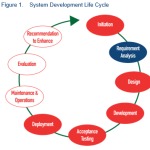 Developing and Sharing Your Business Requirements to Build a Better Data SystemThis DaSy brief follows Key Considerations for Initiating and Planning a New Data System or Major Data System Enhancement and provides Part C/619 staff with an introduction to business requirements, ...Read more
Developing and Sharing Your Business Requirements to Build a Better Data SystemThis DaSy brief follows Key Considerations for Initiating and Planning a New Data System or Major Data System Enhancement and provides Part C/619 staff with an introduction to business requirements, ...Read more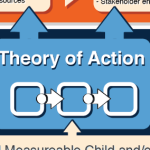 SSIP Phase II Process GuideThis 2015 guide (updated in March of 2016) describes the steps needed to accomplish the work of the three components of Phase II. The SSIP Phase II Process Guide is ...Read more
SSIP Phase II Process GuideThis 2015 guide (updated in March of 2016) describes the steps needed to accomplish the work of the three components of Phase II. The SSIP Phase II Process Guide is ...Read more Use of Data for Fiscal Management of State Part C SystemsThis 2015 document is designed to increase the knowledge and skills of lead agency staff regarding the use of data for appropriate fiscal management of Part C. It provides an ...Read more
Use of Data for Fiscal Management of State Part C SystemsThis 2015 document is designed to increase the knowledge and skills of lead agency staff regarding the use of data for appropriate fiscal management of Part C. It provides an ...Read more Sample SSIP Action Plan TemplateThis 2015 sample action plan template provides states with a suggested, but not required, format and examples of potential content to assist them in completing their Phase II SSIP improvement ...Read more
Sample SSIP Action Plan TemplateThis 2015 sample action plan template provides states with a suggested, but not required, format and examples of potential content to assist them in completing their Phase II SSIP improvement ...Read more Critical Questions About Early Intervention and Early Childhood Special EducationThis 2015 resource can help states examine their data systems, improve programs, and better serve children and families. The questions are grouped into Child & Family, Practitioner, and Local ...Read more
Critical Questions About Early Intervention and Early Childhood Special EducationThis 2015 resource can help states examine their data systems, improve programs, and better serve children and families. The questions are grouped into Child & Family, Practitioner, and Local ...Read more Critical Questions About Early Intervention and Early Childhood Special EducationThis 2015 resource compiles a set of Critical Questions that a quality state data system for early intervention (EI) or early childhood special education (ECSE) should provide data to answer. ...Read more
Critical Questions About Early Intervention and Early Childhood Special EducationThis 2015 resource compiles a set of Critical Questions that a quality state data system for early intervention (EI) or early childhood special education (ECSE) should provide data to answer. ...Read more Recommended Resources for Planning to Evaluate Program Improvement Efforts (including the SSIP)This collection provides a list of recommended existing resources for state Part C and Part B 619 staff and technical assistance (TA) providers to utilize to support evaluation planning for ...Read more
Recommended Resources for Planning to Evaluate Program Improvement Efforts (including the SSIP)This collection provides a list of recommended existing resources for state Part C and Part B 619 staff and technical assistance (TA) providers to utilize to support evaluation planning for ...Read more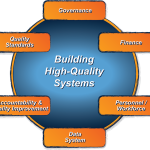 Self-Assessment for ECTA and DaSy FrameworksDeveloped by DaSy and ECTA, the self-assessment is an Excel-based tool that provides a structure for state Part C and Section 619/Preschool programs to record the current status of their ...Read more
Self-Assessment for ECTA and DaSy FrameworksDeveloped by DaSy and ECTA, the self-assessment is an Excel-based tool that provides a structure for state Part C and Section 619/Preschool programs to record the current status of their ...Read more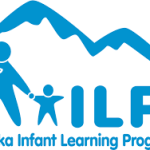 Alaska: Improving Referrals of Victims of Maltreatment to the IDEA Part C ProgramThis 2015 state spotlight document describes how Alaska Part C improved the referral of children from Child Welfare to the Individuals with Disabilities Education Act (IDEA) Part C Program by ...Read more
Alaska: Improving Referrals of Victims of Maltreatment to the IDEA Part C ProgramThis 2015 state spotlight document describes how Alaska Part C improved the referral of children from Child Welfare to the Individuals with Disabilities Education Act (IDEA) Part C Program by ...Read more Working with Stakeholders to Identify Potential Improvement Strategies for Program Improvement (Including the SSIP)This 2015 quick reference guide is designed to assist states in understanding what information needs to be available in order for stakeholders to assist in selecting potential improvement strategies that ...Read more
Working with Stakeholders to Identify Potential Improvement Strategies for Program Improvement (Including the SSIP)This 2015 quick reference guide is designed to assist states in understanding what information needs to be available in order for stakeholders to assist in selecting potential improvement strategies that ...Read more Types of Data SystemsThis 2015 brief describes and compares four common types of data systems that support data from Part C/619 programs: static/reporting, transactional, federated, and centralized. By Tate Gould, Amy Nicholas, Tony Ruggiero, ...Read more
Types of Data SystemsThis 2015 brief describes and compares four common types of data systems that support data from Part C/619 programs: static/reporting, transactional, federated, and centralized. By Tate Gould, Amy Nicholas, Tony Ruggiero, ...Read more
2014
 Data Sharing Agreement Checklist for IDEA Part C and Part B 619 Agencies and ProgramsThis 2014 document is an adaptation of the 2012 release of “Data Sharing Agreement Checklist” intended for K-12 audiences. Presented as a checklist, the document summarizes the requirements for the ...Read more
Data Sharing Agreement Checklist for IDEA Part C and Part B 619 Agencies and ProgramsThis 2014 document is an adaptation of the 2012 release of “Data Sharing Agreement Checklist” intended for K-12 audiences. Presented as a checklist, the document summarizes the requirements for the ...Read more SSIP Phase I Writing Guide: Indicator 11This 2014 guide is intended to support state Part C programs in developing the narrative for Phase I of the SSIP. The guide combines information from a number of key ...Read more
SSIP Phase I Writing Guide: Indicator 11This 2014 guide is intended to support state Part C programs in developing the narrative for Phase I of the SSIP. The guide combines information from a number of key ...Read more Understanding and Using Fiscal Data: A Guide for Part C State StaffThis 2014 document provides an overview of the critical role of fiscal data in state Part C systems. The information is intended to help state Part C lead agency staff ...Read more
Understanding and Using Fiscal Data: A Guide for Part C State StaffThis 2014 document provides an overview of the critical role of fiscal data in state Part C systems. The information is intended to help state Part C lead agency staff ...Read more Data De-identification: An Overview of Basic TermsThis 2014 document is intended to assist early intervention service programs and providers and preschool special education programs and agencies in maintaining compliance with privacy and confidentiality requirements under IDEA ...Read more
Data De-identification: An Overview of Basic TermsThis 2014 document is intended to assist early intervention service programs and providers and preschool special education programs and agencies in maintaining compliance with privacy and confidentiality requirements under IDEA ...Read more Frequently Asked Questions: IDEA Early Childhood – Disclosure AvoidanceThis 2014 document is an adaptation of the 2012 release of Frequently Asked Questions – Disclosure Avoidance intended for K-12 audiences. Presented here in the form of responses to frequently ...Read more
Frequently Asked Questions: IDEA Early Childhood – Disclosure AvoidanceThis 2014 document is an adaptation of the 2012 release of Frequently Asked Questions – Disclosure Avoidance intended for K-12 audiences. Presented here in the form of responses to frequently ...Read more Who Are You Going to Call?This 2014 flyer clarifies the roles of four OSEP Technical Assistance Centers (DaSy, ECTA, IDC, & ECPC) that respond to early childhood state requests and provides examples of who to ...Read more
Who Are You Going to Call?This 2014 flyer clarifies the roles of four OSEP Technical Assistance Centers (DaSy, ECTA, IDC, & ECPC) that respond to early childhood state requests and provides examples of who to ...Read more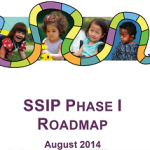 SSIP Phase I RoadmapThis 2014 document provides a description of the activities involved in the development of the SSIP (SPP/APR Indicators C11 and B17) due to OSEP on April 1, 2015. The roadmap ...Read more
SSIP Phase I RoadmapThis 2014 document provides a description of the activities involved in the development of the SSIP (SPP/APR Indicators C11 and B17) due to OSEP on April 1, 2015. The roadmap ...Read more The ABCs of Data DictionariesThis 2014 brief provides an overview of the basic components of a data dictionary and is designed to educate and inform IDEA Part C and Part B 619 state staff ...Read more
The ABCs of Data DictionariesThis 2014 brief provides an overview of the basic components of a data dictionary and is designed to educate and inform IDEA Part C and Part B 619 state staff ...Read more
If you require an accessibility accommodation for any DaSy Resource, please contact DaSy.

